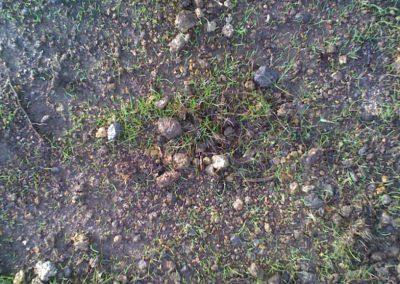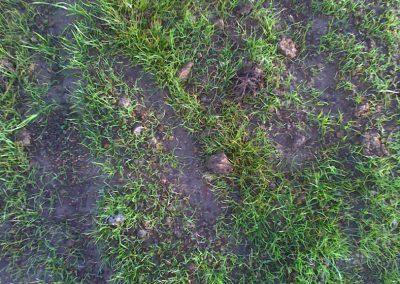Erosion Control
Soil and surface stabilisation practicesTopsoiling and grassing
What, why, when and issues to look out for
What
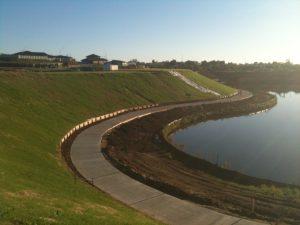
Batters and building platforms on this earthworks site have been stabilised with topsoil and grass (Source: SouthernSkies).
Seeding means planting and establishing vegetation, which for stabilising is usually grass. You often need to place compost or topsoil first. Topsoil is a suitable soil medium for root development and other biological activities. It gives some protection to the subsoil layer and increases the soil’s absorption capacity because, like compost, it holds more water than clay subsoil layers.
Topsoiling and composting are not stabilisation measures in themselves – both need to have the seed added and successfully established.
Why
Topsoiling and grass seeding can provide either short- or long-term cover on disturbed areas. Once established to 80% coverage, the vegetation protects exposed soils from raindrop impact, reduces the speed and amount of runoff and binds the soil particles together.
Rapid-growing annual grass gives short-term cover. It is mainly used when project works are still progressing but need temporary coverage (eg during winter shutdown).
Perennial grasses (lasting for several years) give permanent erosion protection after the earthworks are finished. The ideal method is to add permanent grassing progressively as each area within the project is finalised and brought to final grade.
When
When choosing temporary or permanent seeding
- Either temporary or permanent seeding is useful for short to medium-term stockpiles, the outside of pond embankments or diversion bunds, on cut and fill slopes, access/haul road embankments and any other disturbed areas.
- Either may also be used on rough graded areas that will not be disturbed again for 12 months or more.
- Permanent seeding is used on completed sections of work. It may require a higher quality of surface preparation and a different seed type.
When topsoiling is recommended
- When the texture and/or the organic component of the exposed subsoil or parent material can’t produce adequate vegetative growth
- When the soil material is so shallow that the rooting zone will not be deep enough to support plants or provide continuing supplies of moisture and plant nutrients
- For all exposed loess soils on gentle to moderate slopes
- If you need to establish high quality vegetative cover.
Issues to look out for
Topsoiling and grass seeding have the following limitations:
- The time taken to achieve a stabilised area of grass can vary considerably depending on factors including soil types, seed types and weather conditions. It can take from 4 to 8 weeks, or longer in difficult conditions. You need to plan your time and allow enough time.
- It is harder to establish an expanse of grass during periods of temperature extremes or low rainfall. You may need to plan and sequence your construction so that you can carry out the topsoiling and seeding during periods suitable for vegetation growth – otherwise, plan for and do watering during dry periods.
- Seeds can wash away if they are not harrowed or held in place by mulch or hydroseed.
- Grass seed that has not struck can be mobilised (which means, moved out of place) by intense rainfall, so you may need several applications to achieve the appropriate stabilisation standard.
- Slope length can be a critical factor in establishing grass on a topsoiled slope. If the slope is too long you can expect runoff to form rills, eroding the laid topsoil and removing seed from the lower surfaces. Minimise the length of slopes to avoid this problem.
- Topsoil alone is not a stabilisation method. You will need to have other erosion and sediment control practices in place (eg, mulching) until enough of the grass has grown on the topsoil. The minimum density of grass strike to stabilise soil is 80% coverage.
-
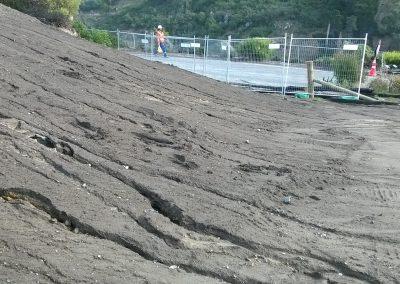
Slope length can negatively affect the stability of topsoiled surfaces—too long and runoff will cause rilling and wash away grass seed.
-
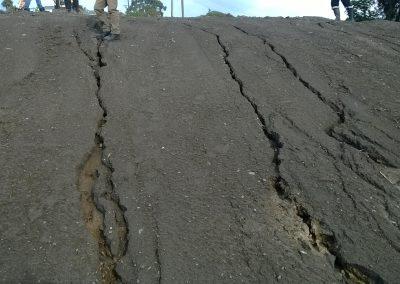
Slope length can negatively affect the stability of topsoiled surfaces—too long and runoff will cause rilling and wash away grass seed.
Design essentials
When preparing the seedbed
- If the site has contaminated material, you will need to fully remove this from the topsoil
- For moderate slopes, texturing the subsoil before you apply the topsoil will give better adhesion than smooth cut surfaces and will prevent erosion and wash-off (which would re-expose the highly erodible subsoil) during heavy rain
- Lay the topsoil at least 100 mm deep, so that the surface is loose and friable (easily crumbled).
When amending the soil
- Apply fertiliser at the rate outlined in Table 9 and consult your fertiliser supplier.
- For large sites or unusual soil conditions, you may need to arrange soil testing. For example, some soils need lime added to improve their pH and/or trace elements for grass growth.
When applying seed and fertiliser
- Consider the site conditions and time of year before going ahead. Establishing grass can take from 4 to 8 weeks, or longer in difficult conditions. You need to plan your time and allow enough time.
- The best seeding windows for both temporary and permanent grassing are autumn and spring. Grass will not strike over winter. However, by using mulch or geotextiles to maintain soil temperatures, or irrigation to supply moisture, you can grass successfully throughout the warmer months.
- If you are seeding during dry or cold periods, apply mulch to protect the seed and soil and to provide a better microclimate for germinating and growing the grass.
- See Table 9 for typical seed mixes. However, seed mixes vary, so consult a seeding contractor before buying.
- Use only fresh, certified seed with a high purity and germination percentage from reputable suppliers that are preferably local. Species selection must consider the project’s ecological context. If permanent seeding is required, consider the final landscape plans
- Apply seed uniformly across the site. Refer to our hydroseeding section if hydroseeding is required.
- For areas flatter than 25%, traditional agricultural techniques such as drill seeding, broadcast seeding, or no tillage can be useful. Make sure that your method achieves a good seed-to-soil contact, to enhance seed survival and germination rates.
- For small areas, hand-broadcasting and raking may also be used to apply seed and fertiliser.
- Apply establishment and maintenance fertiliser at the rate outlined in Table 9.
- If you need to irrigate, deliver a volume at least equal to the evapotranspiration rate (the rate at which water is transferred from the land to the atmosphere by evaporation from the soil and other surfaces and by transpiration from plants). Continue this until natural rainfall provides the necessary soil moisture levels for plant survival.
| Typical seed mix | Application rate | |
|---|---|---|
| Temporary seeding | Annual Ryegrass | 100–250 kg/ha |
| Permanent seeding | Perennial Ryegrass — 70% Fescues/Cocksfoot — 20% Clover/Lotus — 5% Browntop — 5% |
200–400 kg/ha |
| Fertiliser application | N:P:K (15:10:10) | 200–800 kg/ha |
| Maintenance fertiliser | N:P:K (15:10:10) and Urea | As required |
Note: Always check that the seed and fertiliser application rates and mix are appropriate for your site, and discuss with your suppliers before you use them.
Construction, operation and maintenance
When constructing and operating topsoiling and grassing
- It is important to prepare a good seedbed so that the grass seed can grow well. The seedbed should be loose, uniform and free of large clods and other objectionable material. The soil surface should not be compacted or crusted.
- Topsoil is a valuable resource. If you are putting it in a stockpile, isolate this by the upslope diversion of clean water runoff, stabilise it, and keep the pile under 3 m high to maintain the soil structure and integrity.
When maintaining topsoiling and grassing:
- Check the condition of the topsoil regularly, and re-grade or replace it if necessary. Keep the topsoil at least 100 mm deep, with the appropriate surface roughening.
- Heavy rainfall can wash new seeding away in any circumstances, but especially on smoother hard surfaces, steep slopes and overland flow paths.
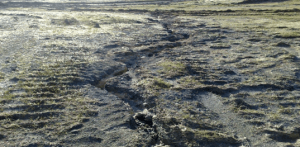
Loss of topsoil and grass seed after a heavy rain event. Re-stabilisation and reapplication for grass seed is required. (Source: Southern Skies).
- If the grass hasn’t established itself well enough, you will need to re-seed the area or consider other stabilisation techniques.
- Apply additional fertiliser dosing at the ratio of 15:10:10 (N:P:K) approximately 6 to 12 weeks after seeding, or as required.
- Protect all re-vegetated areas from construction traffic and other activities such as the installation of drainage lines and utility services. If required, erect temporary barrier fencing and/or signage to restrict uncontrolled movement.
